The delight of eating at a local trattoria is being among real Italians and eating seasonal, traditional food. Mario Matassa shares his favourite establishment with us, and goes behind the scenes of this Italian Restaurant…
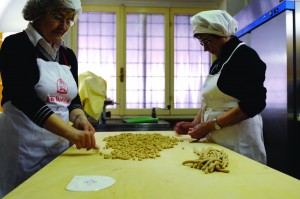 The local trattoria in Italy is a theatre, a daily stage show where hundreds of life’s mini dramas are eagerly played out every day. Walk into any good trattoria or restaurant in any small town in Italy and you are entering into more – much more – than simply a place to eat. It doesn’t matter that there’s no menu – in fact, that’s precisely the point. Eating in Italy is not all about what you choose to eat. Nor is it about the number of stars above the door, the length and breadth of the wine list or the stitch of the tablecloth. It is about the experience of eating. For Italians, the subject of eating and living are intertwined and the experience of eating – whether at home or in the restaurant – bespeaks an attitude that makes of it a daily festa.
The local trattoria in Italy is a theatre, a daily stage show where hundreds of life’s mini dramas are eagerly played out every day. Walk into any good trattoria or restaurant in any small town in Italy and you are entering into more – much more – than simply a place to eat. It doesn’t matter that there’s no menu – in fact, that’s precisely the point. Eating in Italy is not all about what you choose to eat. Nor is it about the number of stars above the door, the length and breadth of the wine list or the stitch of the tablecloth. It is about the experience of eating. For Italians, the subject of eating and living are intertwined and the experience of eating – whether at home or in the restaurant – bespeaks an attitude that makes of it a daily festa.
The day starts with pasta. Every day the doors open just before noon but the restaurant comes to life much earlier. Like many a good meal, it starts with the pasta. I arrive at the Crocetta, my local trattoria, just after 8.00am. I go through the side entrance, which leads directly into the main kitchen area. It’s deserted, but not entirely without life. There’s a large pot of tomato sauce, half covered, simmering gently on the stove, and the tantalising aroma of mixed roasts in the oven tells me that lunch is already under way. Immediately my stomach reminds me that perhaps it wasn’t such a good idea to skip breakfast.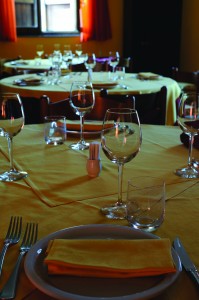
The issue’s quickly resolved. Gabriella Bertoni, the restaurant’s proprietor, appears from the side kitchen, her apron covered in a light dusting of flour – an unmistakable sign that she’s been making pasta. Before I have a chance to set to work she takes me into the bar, makes coffee and offers a freshly baked brioche. Her priorities are firmly in order. Breakfast in Italy is the only meal eaten with any real sense of urgency – a necessity rather than something to be lingered over.
Soon after we return to the side kitchen where Denis, the chef, and Maria Pia are preparing the fresh pasta of the day. Today it’s pisareï, a local Piacentine speciality. Made entirely by hand, it’s a time-consuming labour of love. Long strands of pasta dough, made from a mix of flour, breadcrumbs and water, are rolled out, cut into small neat little dumplings barely larger than a bean and individually twisted under thumb to create a pocket to hold the sauce. Later they will be boiled in salted water and served in a red tomato sauce with borlotti beans – locally known as pisareï e fasò. They could use a machine to make the pisareï, Gabriella explains, “but people would know”. More than any other part of Italy, fresh pasta in Emilia-Romagna is expected. “It’s tradition here,” Gabriella says, not complaining, merely stating a fact. They gossip, joke and laugh, barely looking as they continue to roll, cut and twist the tiny gnocchi. Gabriella learned her skills from her mother, who ran the kitchen for some 20 years before her. The whole process takes well over an hour, but it’s an effort that restaurants in the area can’t choose to forgo.
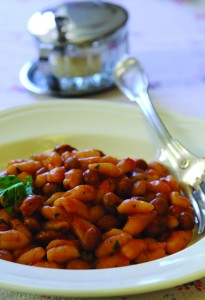 EATING LOCAL
EATING LOCAL
Practically every restaurant in the province of Piacenza will list pisareï e fasò on its menu. Other pasta dishes will invariably include fresh anolini brodo (cheese- or meat-filled ravioli cooked in broth) and tortelli (a type of ravioli stuffed with ricotta and spinach). Main dishes will usually include coppa arrosto (roast pork), vitello arrosto (roast veal), roast poultry (sometimes guinea fowl, sometimes duck, often both) and a steak, simply grilled. It’s a very safe bet to say that every menu will also feature an antipasto of mixed salumi served with gnocco fritto (fried bread dough). The dessert list may well begin and end with a crostata (a jam tart), panna cotta or semi freddo.
Predictability is a facet of Italian provincial menus. Wherever I go to eat near home – or within the provincial boundaries – it’s only force of habit that bothers me to open a menu, should one be made available. More often than not, I could close my eyes and recite the menu just as my son recites his five-times-table, with a degree of accuracy that I know he is achieving in the classroom. But this isn’t due to either culinary monotony or lack of imagination.
It can seem strange to anyone unaccustomed to Italian provincial life that people will, on a regular basis, go out to eat at their local trattoria and likely order a dish that they have eaten perhaps a thousand times at home. When I lived in London, the first question when dining out was always, “What will it be tonight?” With the diversity of the world’s cuisine on our doorstep, arguments over whether it would be Indian food or perhaps Chinese, a pizza or pasta, fish or steak could often only be resolved after a show of hands. In provincial Italy, no such difficulty arises. More likely than not it’s either pizza or pasta and, if you’re lucky (as I am), your local trattoria just might serve both. That way, everyone’s a winner!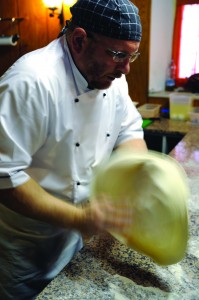
Italians, or at least my Italian neighbours here in the provinces, do not seek diversity but rather predictability. Familiarity is a comfort, and so every time an Italian enters a restaurant they do so with a sense of expectation. Restaurants are governed by seasonality, locality and tradition because restaurant owners, like their customers, have grown up with food that is seasonal, local and traditional. It’s a principle that’s applied both at home and in the restaurant.
This is not to say, of course, that Italians are uncritically resigned to the food they are served. On the contrary, because despite the seeming disinterest in diversity and deep contentment with the familiar, that same bowl of pisareï will be tasted, analysed and judged in the most minute detail; the same glass of unpretentious local red wine will be slurped and debated with the animation and joie as if it were a Grand Cru; and the same piece of roast that’s cooked in every other restaurant in town will be carefully compared and assessed for quality. If there’s anything Italians love more than eating good food, it’s talking about it while they eat!
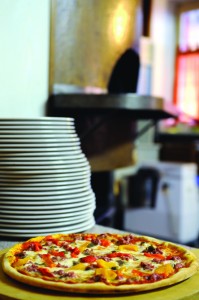 LUNCH TIME… SHOW TIME!
LUNCH TIME… SHOW TIME!
Back in the kitchen, Denis has gone into overdrive. The large stove is now clouded in a steaming mist from boiling pans. Plates and bowls are stacked in waiting and trays of roast meat are resting by the oven, waiting to be sliced. The whole family is now on duty. Carlo, Gabriella’s husband, is slicing platters of affettato (cured meats) in anticipation of the initial rush. Her son, Paolo, is arranging carafes for water and wine behind the bar while Gabriella makes a last-minute check that the dining hall is in order.
Carlo, Gabriella’s 85-year-old father, has seen it all before and takes it in his stride. He ushers me over to the bar for a glass of white wine and waits to greet the first customers. He doesn’t have to wait long before a group of operai (workmen) restructuring a nearby house arrive. They won’t have much time and will most likely opt for the menu fisso – a fixed-price menu that offers two courses and coffee.
It shouldn’t be confused with a menu turistico, also a set menu offered at a fixed price. The menu fisso is the bread-and-butter of many small family-run businesses in the provinces. They rely on a regular flow of agricultural workers, builders, tradesmen and local shop workers, so the food has to be a good standard. At the Crocetta the choice always includes at least one fresh pasta dish. Today it’s pisareï e fasò, always popular.
Moments later my own family arrives. Carlo tells us to sit at our usual table and he’ll bring a carafe of wine and water. Hearing the children walking through, Gabriella follows with bread and grissini sticks with a speed that suggests an emergency – or rather, a potential emergency avoided. Quickly the dining room fills: more workmen, the manager of one of the local wine cantinas, my next-door neighbours and their children, the dentist and his wife, Gabriella’s brother with a group of friends. I notice my local mechanic arriving. Instinctively he sits at a table in the far corner pre-set for one and with the remainder of yesterday’s bottle of wine. He takes the same table every day, and has done for the past 15 years. I’ll give him time to eat his pasta and catch him between courses – I need the brakes checked on the car.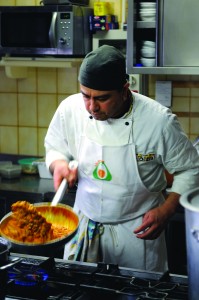
Gabriella is running frantically between tables, bringing bread and taking orders. The children, grissini sticks dispensed, have grown bored and are playing in the middle of the floor. Another two children from my elder son’s class have joined them but no one seems bothered. Carlo walks around the newly established play area to bring wine and water to our table. Gabriella arrives to take our order. We too opt for the menu fisso, ordering five bowls of pasta and beans, followed by grilled pork chops and mixed green salad. There is no special children’s menu – the only dispensation in their direction, a bowl of chips to accompany their chops. In Italy, children have always been expected to eat exactly what their parents eat – in doing so, from a very early age they too develop that innate sense of expectation.
There’s a couple from Liguria on a day trip sitting at the table next to us. They have an infant baby with them who miraculously sleeps through the whole commotion. Unfamiliar to the area, I can see them looking around, observing, gauging the restaurant in the all-too-familiar way all Italians gauge restaurants. People are talking to each other between tables. Gabriella is acknowledging most of the diners on a first-name basis. Very quickly they realise that they are witnessing centre stage an ongoing communal soap opera and that they are the only strangers eating in the restaurant. It reminds them of their own local trattoria at home and they immediately feel comfortable, on familiar territory. They are in a restaurant that ‘belongs’. The young mother momentarily catches my wife’s eye, smiles and says: “We chose wisely today.”
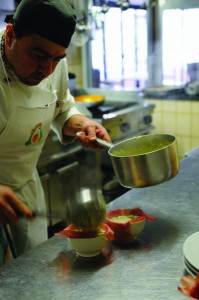 THE AFTERNOON SHIFT
THE AFTERNOON SHIFT
By 1.45pm it’s all over – lunch, that is. Most of the diners have left. One table of stragglers, fully fed, signals Carlo to bring a much-needed digestivo. He arrives smiling with a bottle of something he made himself and leaves it on the table.
Inside the kitchen Denis is clearing dishes from the dishwasher. There’s a large pot of stew – the beginning of one of tomorrow’s specials – bubbling gently on the stove. Gabriella is filling salt shakers and emptying out bread baskets. Ivan arrives to light the oven and start making the pizza dough for later that evening. Most restaurants only serve pizza in the evenings. By 3.30pm, everything is ready and for just a couple of hours, the restaurant falls silent.
EATING OUT, EATING IN
The passion for good food in Italy is not so much a desire for pasta served with a choice of 20 different sauces, pizza covered in exotic toppings, or wines with fanciful labels and a price tag to match. For most Italians the gauge of a good restaurant is the extent to which it makes them feel like they are eating at home.
In the provinces, the food eaten in the local trattoria will seldom differ greatly from the food that is customarily eaten at home. The lack of interest in diversity, the deep and faithful contentment with the familiar, bespeaks an attitude that tells us that food has to be more than just the contents of the plate. In Italy, good food is the experience of eating with all its flavour, drama, animation, excitement and joy.
FURTHER INFORMATION
Crocetta Pizzeria and Trattoria
Via Crocetta 26 , Castell’Arquato, Piacenza, Emilia-Romagna
+39 052 380 3525
